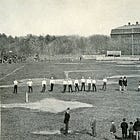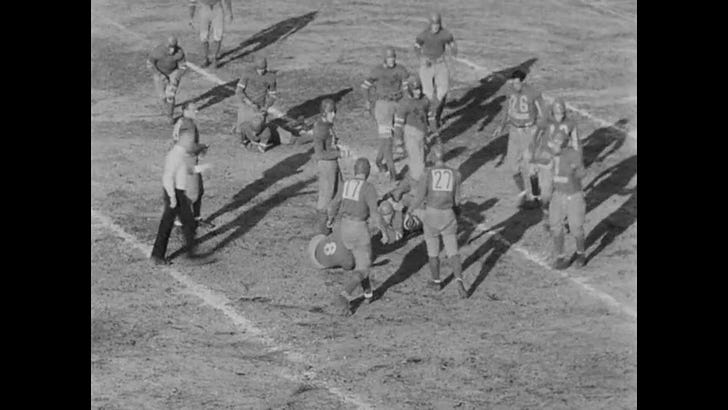The Name of the Game: Canadian Rugby or Football?
Canada has been in the news recently, mainly due to the policies of the White House’s current occupant, but this story is about names, specifically the name of the game North Americans call football, a name that wasn't always shared on both sides of the border. I've thought about this issue for several years, researching it off and on, and I've always become frustrated by never finding anything written about the topic.
Football regularly changes its terminology for positions, plays, and techniques, but those are small potatoes. It is a bigger deal to rename your sport, which Canada did when they shifted from calling their game Canadian rugby to Canadian football.
I am neither a linguist nor an expert on Canadian football and culture. Still, Canada is a great country, and the recent events, plus a 1955-1957 Spalding Canada Fall and Winter catalog, got me thinking about this issue again.
Inside that catalog is a page promoting the J5-V football, which descends from Spalding's Model J ball adopted by the Intercollegiate Football Association in 1892. The catalog page from 1956 tells us the J5-V is the official ball of the Grey Cup and All-Star football, whiel the first line of text proclaims it “the Official Canadian Rugby Union football." Tell me if I am wrong, but you would think they would call it a rugby ball if they were playing rugby. On the other hand, they should call the sport football if they were playing football, but they chose not to, at least as of 1956.
When Spalding Canada's catalog came out In 1956, the sport's governing body, the Canadian Rugby Union (CRU), oversaw a game that looked and smelled like football, not rugby, though it had distinctly Canadian features like a big field and three downs. The CRU oversaw the amateur game and the two professional leagues, the five-team Western Interprovincial Rugby Union and the Interprovincial Rugby Football Union, or Big Four, in Ontario and Quebec. Early in 1956, the two pro leagues formed the Canadian Football Council to "coordinate" activities between the leagues. The result of the Council was the formation of the Canadian Football League in January 1958. See what they did there? They went from two leagues with rugby in their names to one league with football in its name.
America never had to face that problem. For centuries, "football" referred to various English kicking games with varying local rules, but the games began formalizing in the mid-1800s. Association football, or soccer, formed a ruling body and went one direction, while rugby football formed a different ruling body and went another. When the American colleges adopted rugby as their game in 1876, they borrowed the rules of England's Rugby Football Union or the Football Association of Canada. Since Canada's rules were word-for-word, the same as the English rules, it doesn't matter which one we copied. A few American colleges formed the Intercollegiate Football Association and tweaked a few rules, but we called it football from the beginning. We sometimes called it rugby football, but only to distinguish it from soccer football.
Canada took a different path. They renamed their ruling body the Canadian Rugby Football Union by 1880 and the Canadian Rugby Union in 1891. So, as both countries drifted away from English rugby, they called their game Canadian rugby, and we called ours football. The folks up north could have called their game rugby, but as an English dominion, Canadians continued playing English rugby more than Americans -especially in Nova Scotia and British Columbia- English rugby kept the name rugby, and their rugby derivative was Canadian rugby.
Over many decades, however, Canadian rugby shifted further away from English rugby and took on more elements of American football. A similar shift appeared in the language.
At the turn of the last century, Canadian newspapers often referred to rugby football players, but as time passed, they became football players. Likewise, the sport shifted from being called Canadian rugby to Canadian football, at least in the newspapers. Canadian sports pages in the 1910s and beyond covered American college football and, later, the NFL, so, depending on the context, they used Canadian football or just football when referring to their game.
Nevertheless, rugby remained in the league names well after the sport left rugby behind and became much more like American football. While Canadian Rugby and American football had different rules, the skills and tactics were similar, so players and coaches switched from one another with relative ease. American and Canadian teams also played one another, with the last NFL-CFL exhibition matchups played in 1961.
After the Canadian professionals adopted football as the sport's name in 1958, they left the CRU, so the CRU oversaw the amateur game only. It was renamed the Canadian Amateur Football Association in 1966 and became Football Canada in 1986, which remains the governing body's name today.
A linguist who understands language shifts better than I might have fun looking at this issue, but companies and brands change names for many reasons, often when their name no longer communicates what their products and services are all about. The same challenge hit Canadian rugby by 1958, at which point they officially embraced football as the name of their sport.
Now, if the guy in the White House would shut his yap for a while, our countries could return to being good friends and partners. However, Canada’s willingness to call their game rugby a few decades longer than needed suggests they have long memories and a stubborn streak. Unfortunately, America will regret threatening our wonderful northern neighbor for years to come.
Other stories about Canadian football:
Others are available using the search function.
Click Support Football Archaeology for options to support this site beyond a free subscription.









This is quite interesting in view of a story I once read about a nineteenth century Canadian university team that traveled to the U.S. to play against a U.S. university team. This was at a time when official rule books were not yet common. The Canadians discovered that their U.S. opponents played a game with more holdover rules from soccer! It seems that we yankees owe our Canadian cousins a thank you for pushing us closer to gridiron football!
The use of "prolate spheroid" by the NCAA, NFL, and USports in their rulebooks has become a bee in my bonnet. The ball probably hasn't been a prolate spheroid since the early 1900's. It's that 'ogive' part that you've mentioned. Rugby and Australian Rules both state the ball is 'oval' (also the incorrect mathematical term, because that refers to a 2-D shape). They could use prolate spheroid (an ellipse or oval rotated along its long axis) or ovoid. The American/Canadian ball is mathematically a lemon, the intersection of two spheres. And since the 1934 dimensions the profile of the ball is, or is very closely related to, a vesica piscis.
I think it might be one of those situations where the truth is superseded by custom and it won't change.